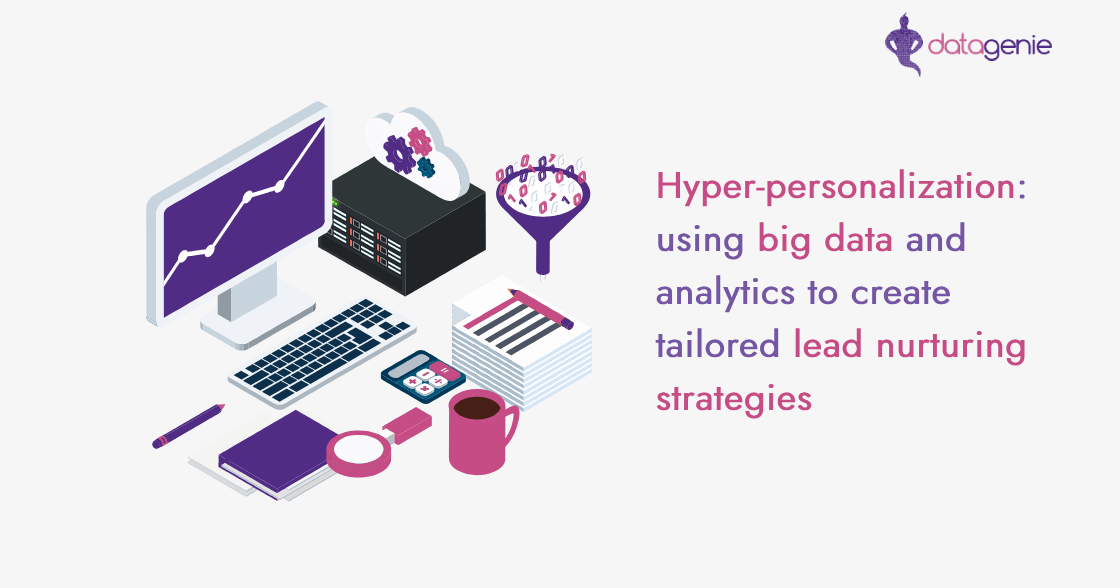Hyper-personalization: using big data and analytics to create tailored lead nurturing strategies
Published On:
September 12, 2023

Introduction
In the age of the digital economy, consumers are bombarded with countless advertisements, emails, and promotional messages every day. This makes it essential for businesses to cut through the noise and ensure their communications stand out. Enter hyper-personalization — a strategy that goes beyond the simple “Hello, [Erick]” approach. Through the powerful fusion of Big Data and analytics, companies can now devise tailored lead nurturing strategies that resonate deeply with individual consumers. In this blog post, we’ll delve into how hyper-personalization is revolutionizing lead nurturing and transforming customer experiences.
1. Understanding hyper-personalization
1.1. What is hyper-personalization?
Hyper-personalization is the practice of crafting marketing and sales communications based on individual consumer preferences, behaviour, and real-time data. Unlike traditional personalization, which might simply use a person’s name or basic demographic details, hyper-personalization leverages vast amounts of data to create a unique, tailored experience for each user.
1.2. The shift from personalization to hyper-personalization
While personalization might involve segmenting your audience into broad categories, hyper-personalization delves deeper. It’s the difference between sending a generic email to all millennials and sending a specialized email to a millennial who’s shown interest in eco-friendly products in the past month. The latter is likely to yield much better results.
2. The power of big data in lead nurturing
2.1. Gathering multifaceted consumer insights
Big Data offers insights from multiple sources like social media activity, browsing behavior, purchase history, and even offline interactions. By collecting and analyzing this data, businesses can gain a 360-degree view of their leads, understanding not just who they are, but what they truly want.
2.2. Real-time response
Big Data isn’t just voluminous; it’s fast. This means businesses can adjust their strategies in real-time based on current consumer behavior. For example, if a potential lead looks at a product page but doesn’t purchase, businesses can immediately send a tailored discount offer to entice them.
Get started with Datagenie B2B prospecting platform
emails in 15 million companies.
3. Analytics: the backbone of hyper-personalization
3.1. Predictive analytics for proactive strategy
Predictive analytics tools use historical data to predict future actions of leads. For instance, if data shows that a user frequently purchases athletic wear in March, businesses can proactively send them related offers in anticipation.
3.2. Behavior-based personalization
Analytics can map out a user’s journey, from the first point of contact to the final sale, revealing patterns and preferences. By recognizing these behaviors, businesses can provide relevant content or offers at every stage of the customer journey, increasing the chances of conversion.
4. Implementing hyper-personalized lead nurturing strategies
4.1. Start with clean, quality data
The success of any hyper-personalization strategy begins with quality data. Ensure that your data sources are reliable and that the data is cleaned and structured. Irrelevant or outdated data can lead to misguided strategies. Use DataGenie prospecting platform for the most accurate online database of B2B contact data.
4.2. Use advanced machine learning and AI tools
While manual data analysis has its place, the scale of Big Data demands advanced tools. AI and machine learning can process vast amounts of data swiftly and provide actionable insights, making them indispensable for hyper-personalization.
4.3. Test, analyze, adjust
The digital landscape is always changing. It’s vital to regularly test your strategies, analyze their effectiveness, and make adjustments. What works today might not work tomorrow, so stay agile and open to change.
5. The future of lead nurturing
With advancements in technology, we can expect hyper-personalization to become even more refined. We might see innovations like virtual reality shopping experiences tailored to individual preferences or AI chatbots that can predict a user’s needs before they even articulate them.
However, it’s essential to remember that with great power comes great responsibility. As we harness Big Data for hyper-personalization, maintaining user privacy and data security must remain paramount.
6. Challenges and ethical considerations
6.1. Data privacy and consent
As hyper-personalization relies heavily on collecting and analyzing personal data, businesses must navigate data privacy regulations. Transparency in data usage and offering opt-out options are essential to build trust and maintain compliance. DataGenie sourced data complies with the legal basis for data processing.
6.2. Avoiding over-personalization
There’s a fine line between effective hyper-personalization and over-personalization that can come across as intrusive. Bombarding leads with highly personalized content can lead to discomfort and even alienation. Striking the right balance by providing value without overwhelming the lead is crucial.
Conclusion
Hyper-personalization, powered by Big Data and analytics, is no longer a mere buzzword; it’s an essential strategy for businesses aiming to create meaningful relationships with their leads. By understanding and anticipating individual needs, companies can craft experiences that resonate on a personal level, turning leads into loyal customers. As technology continues to evolve, those who can skilfully navigate the world of hyper-personalization will undoubtedly stay ahead in the game of lead nurturing.




